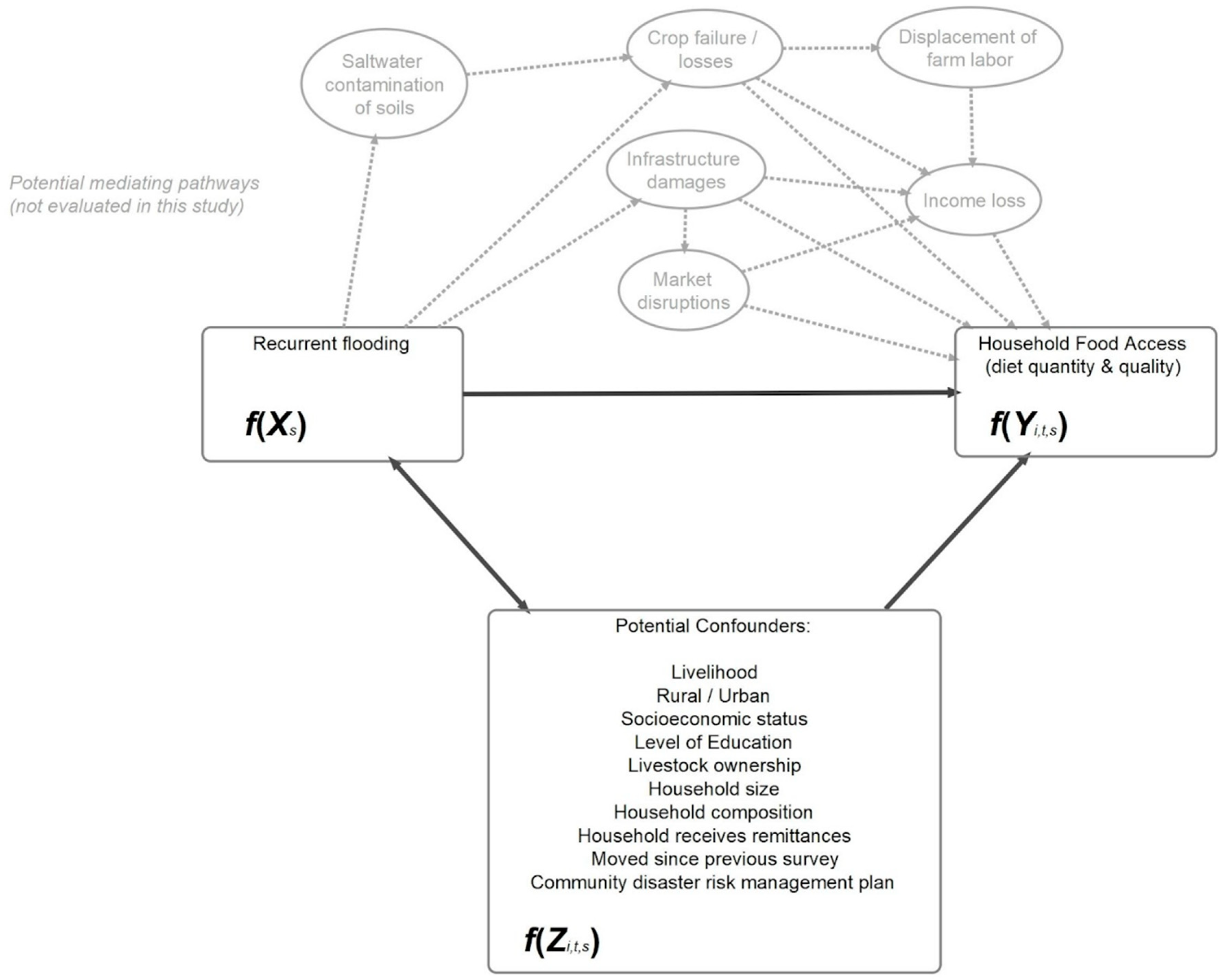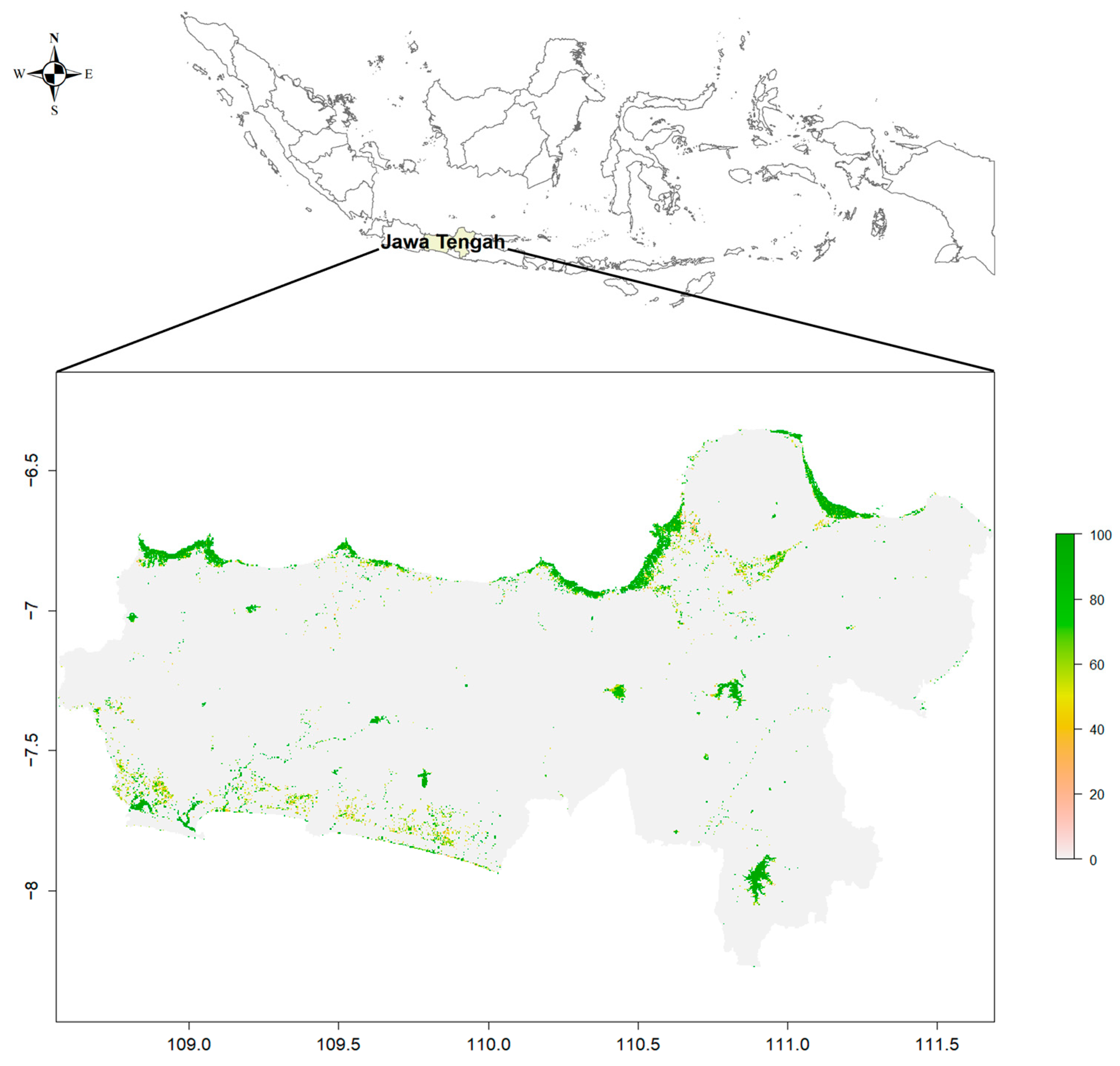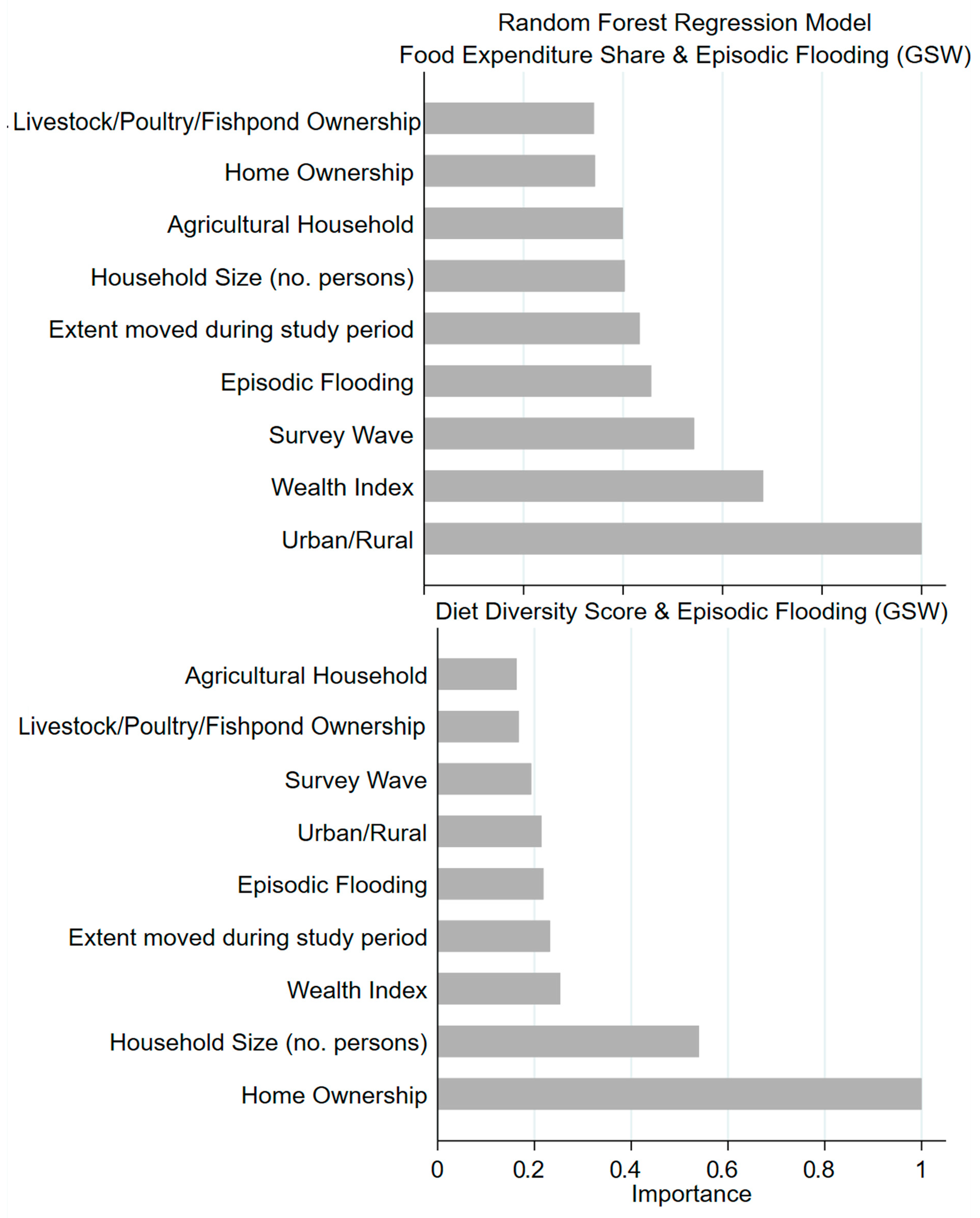Recurrent Flooding and Household Food Access in Central Java, Indonesia
Abstract
1. Introduction
2. Materials and Methods
2.1. Data Sources and Survey Design
2.2. Dataset Preparation
2.3. Variables
2.4. Modeling
3. Results
| Characteristic | Variable | First Wave |
|---|---|---|
| Sample size | 2265 | |
| Livelihood | Has land for farming 3 | 269 (22%) |
| Anyone was a farmer in the past year | 755 (34%) | |
| Anyone engaged in fishing (non-fishery) 3 | 10 (9%) | |
| Livestock ownership | Owns livestock/poultry/fishpond | 619 (27%) |
| Highest level of education 2 | Elementary | 507 (35%) |
| Junior High General | 311 (21%) | |
| Junior High Vocational | 10 (1%) | |
| Senior High General | 187 (13%) | |
| Senior High Vocational | 192 (13%) | |
| College | 75 (5%) | |
| University (Bachelor/Master/Dr) | 171 (12%) | |
| Household composition | Household size | 3.74 (1.89) |
| Housing characteristics | Rural | 1201 (53%) |
| Number of rooms 4 | 5.44 (2.53) | |
| House is self-owned | 1575 (70%) | |
| Uses electricity 4 | 1969 (87%) | |
| Flooring | Ceramic/marble/granite/stone or tiles or cement/bricks or lumber/board 4 | 1579 (70%) |
| Walls | Masonry (cement/prefabricated bricks) or lumber/board/plywood 4 | 1973 (87%) |
| Roof | Concrete or roof tiles/shingles 4 | 1947 (86%) |
| Drinking/cooking water | Improved source (piped, well, spring, rain) | 1883 (84%) |
| Bath/laundry water | Improved source (piped, well, spring, rain) 4 | 2017 (89%) |
| Toilet type | Improved facility (own toilet, septic system) 4 | 1392 (62%) |
| Sewage disposal | Improved system (drainage ditch, permanent pit) 4 | 1536 (68%) |
| Garbage disposal | Collection by sanitation service 4 | 549 (24%) |
| Assets (ownership by any household member) | House and land occupied by household | 1596 (71%) |
| Other house or building (including land) 4 | 151 (7%) | |
| Vehicles (cars, boats, bicycles, motorbikes) 4 | 1168 (52%) | |
| Household appliances (radio, fridge, TV, etc.) 4 | 1775 (79%) | |
| Jewelry 4 | 1236 (55%) | |
| Savings 4 | 684 (30%) | |
| Receivables 4 | 285 (13%) | |
| Access to credit | Know of a place to borrow money 3 | 1236 (88%) |
| Ever borrowed money 3 | 42 (27%) | |
| Secured a loan (past 12 months) 3 | 275 (22%) | |
| Household assistance | Received money from a community group 3 | 6 (2%) |
| Received cash assistance 3 | 149 (12%) | |
| Received any assistance from government or NGO 3 | 455 (36%) | |
| Expenditure | Monthly household expenditure | 1,211,335.75 (1,756,339.13) |
| Interviewer observation of house | Moderate size yard 4 | 1344 (59%) |
| Well-kept yard 4 | 1735 (77%) | |
| Adequate ventillation 4 | 1762 (78%) | |
| Stable under/next to house | 447 (20%) | |
| House surrounded by puddles | 148 (7%) | |
| Piles of trash around house | 159 (7%) | |
| Human and animal waste near house | 133 (6%) | |
| Wealth index | Score | −0.28 (2.01) |
| Lowest quintile | 580 (26%) | |
| Mid-low quintile | 429 (19%) | |
| Medium quintile | 418 (19%) | |
| Mid-high quintile | 395 (18%) | |
| Highest quintile | 424 (19%) | |
| Community/village characteristics 2 | Coastal | 132 (10%) |
| Blocked water duct or obstructed river/gutter | 320 (23%) | |
| Standing pools of water (not marshes, lakes) | 329 (24%) |
4. Discussion
5. Conclusions
Author Contributions
Funding
Institutional Review Board Statement
Informed Consent Statement
Data Availability Statement
Acknowledgments
Conflicts of Interest
References
- The Impact of Disasters and Crises on Agriculture and Food Security: 2021; Food and Agriculture Organization of the United Nations: Rome, Italy, 2021.
- Agriculture on the Proving Grounds: Damage and Loss; Food and Agriculture Organization of the United Nations: Rome, Italy, 2021; Available online: https://www.fao.org/resources/digital-reports/disasters-in-agriculture/en/ (accessed on 21 November 2021).
- Fanzo, J.; Davis, C.; McLaren, R.; Choufani, J. The effect of climate change across food systems: Implications for nutrition outcomes. Glob. Food Sec. 2018, 18, 12–19. [Google Scholar] [CrossRef]
- Salm, L.; Nisbett, N.; Cramer, L.; Gillespie, S.; Thornton, P. How climate change interacts with inequity to affect nutrition. Wiley Interdiscip. Rev. Clim. Chang. 2021, 12, e696. [Google Scholar] [CrossRef]
- Core Writing Team; Lee, H.; Romero, J. (Eds.) Climate Change 2023: Synthesis Report. A Report of the Intergovernmental Panel on Climate Change. Contribution of Working Groups I, II and III to the Sixth Assessment Report of the Intergovernmental Panel on Climate Change; IPCC: Geneva, Switzerland, 2023. [Google Scholar]
- Niles, M.T.; Emery, B.F.; Wiltshire, S.; E Brown, M.; Fisher, B.; Ricketts, T.H. Climate impacts associated with reduced diet diversity in children across nineteen countries. Environ. Res. Lett. 2021, 16, 15010. [Google Scholar] [CrossRef]
- Data4Diets: Food Security Indicators | INDDEX Project. Available online: https://inddex.nutrition.tufts.edu/data4diets/indicators (accessed on 21 July 2021).
- Gabrysch, S.; Waid, J.L.; Wendt, A.S.; Müller, A.A.; Kader, A.; Gosh, U. Nutritional effects of flooding due to unseasonably early monsoon rainfall in Bangladesh: A cross-sectional study in an ongoing cluster-randomised trial. Lancet Planet. Health 2018, 2, S3. [Google Scholar] [CrossRef]
- Oskorouchi, H.R.; Sousa-Poza, A. Floods, food security, and coping strategies: Evidence from Afghanistan. Agric. Econ. 2021, 52, 123–140. [Google Scholar] [CrossRef]
- Doocy, S.; Leidman, E.; Aung, T.; Kirsch, T. Household economic and food security after the 2010 Pakistan floods. Food Nutr. Bull. 2013, 34, 95–103. [Google Scholar] [CrossRef]
- Ambikapathi, R.; Kosek, M.N.; Lee, G.O.; Olortegui, M.P.; Zaitchik, B.; Yori, P.P.; Bauck, A.; Caulfield, L.E. La Niña weather impacts dietary patterns and dietary diversity among children in the Peruvian Amazon. Public Health Nutr. 2021, 24, 3477–3487. [Google Scholar] [CrossRef]
- Phalkey, R.K.; Aranda-Jan, C.; Marx, S.; Höfle, B.; Sauerborn, R. Systematic review of current efforts to quantify the impacts of climate change on undernutrition. Proc. Natl. Acad. Sci. USA 2015, 112, E4522–E4529. [Google Scholar] [CrossRef]
- Rodriguez-Llanes, J.M.; Ranjan-Dash, S.; Degomme, O.; Mukhopadhyay, A.; Guha-Sapir, D. Child malnutrition and recurrent flooding in rural eastern India: A community-based survey. BMJ Open 2011, 1, e000109. [Google Scholar] [CrossRef]
- Gaire, S.; Delbiso, T.D.; Pandey, S.; Guha-Sapir, D. Impact of disasters on child stunting in Nepal. Risk Manag. Healthc. Policy 2016, 9, 113–127. [Google Scholar] [CrossRef]
- Rodriguez-Llanes, J.M.; Ranjan-Dash, S.; Mukhopadhyay, A.; Guha-Sapir, D. Flood-Exposure is Associated with Higher Prevalence of Child Undernutrition in Rural Eastern India. Int. J. Environ. Res. Public Health 2016, 13, 210. [Google Scholar] [CrossRef]
- Lieber, M.; Chin-Hong, P.; Kelly, K.; Dandu, M.; Weiser, S.D. A systematic review and meta-analysis assessing the impact of droughts, flooding, and climate variability on malnutrition. Glob. Public Health 2022, 17, 68–82. [Google Scholar] [CrossRef]
- Alderman, K.; Turner, L.R.; Tong, S. Floods and human health: A systematic review. Environ. Int. 2012, 47, 37–47. [Google Scholar] [CrossRef]
- Ahern, M.; Kovats, R.S.; Wilkinson, P.; Few, R.; Matthies, F. Global Health Impacts of Floods: Epidemiologic Evidence. Epidemiol. Rev. 2005, 27, 36–46. [Google Scholar] [CrossRef]
- Gepp, S.; Waid, J.L.; Brombierstäudl, D.; Kader, A.; Müller-Hauser, A.A.; Wendt, A.S.; Dame, J.; Gabrysch, S. Impact of unseasonable flooding on women’s food security and mental health in rural Sylhet, Bangladesh: A longitudinal observational study. Lancet Planet. Health 2022, 6, S14. [Google Scholar] [CrossRef]
- Parvez, M.; Islam, M.R.; Dey, N.C. Household food insecurity after the early monsoon flash flood of 2017 among wetland (Haor) communities of northeastern Bangladesh: A cross-sectional study. Food Energy Secur. 2022, 11, e326. [Google Scholar] [CrossRef]
- Marfai, M.A.; King, L.; Singh, L.P.; Mardiatno, D.; Sartohadi, J.; Hadmoko, D.S.; Dewi, A. Natural hazards in Central Java Province, Indonesia: An overview. Environ. Geol. 2008, 56, 335–351. [Google Scholar] [CrossRef]
- Marfai, M.A.; King, L. Tidal inundation mapping under enhanced land subsidence in Semarang, Central Java Indonesia. Nat. Hazards 2008, 44, 93–109. [Google Scholar]
- Climate Disasters in Indonesia 2023 Will Be Dominated by Floods. Available online: https://asiatoday.id/read/climate-disasters-in-indonesia-2023-will-be-dominated-by-floods (accessed on 10 October 2024).
- Lassa, J.A. Emerging ‘Agricultural Involution’ in Indonesia: Impact of Natural Hazards and Climate Extremes on Agricultural Crops and Food System. In Economic and Welfare Impacts of Disasters in East Asia and Policy Responses; ERIA Research Project Report 2011-8; ERIA: Jakart, Indonesia, 2012; Available online: https://www.eria.org/Chapter_16.pdf (accessed on 1 August 2024).
- Harwitasari, D.; van Ast, J.A.A. Climate change adaptation in practice: People’s responses to tidal flooding in Semarang, Indonesia. J. Flood Risk Manag. 2011, 4, 216–233. [Google Scholar]
- Harwitasari, D.; van Ast, J.A. Adaptation Responses to Tidal Flooding in Semarang, Indonesia; Erasmus University: Rotterdam, The Netherlands, 2008. [Google Scholar]
- Langlois, B.K.; Beaulac, L.; Berry, K.; Anyanwu, O.; Simpson, R.B.; Ismanto, A.; Koch, M.; de Perez, E.C.; Griffin, T.; Naumova, E.N. Household Flood Severity and Migration Extent in Central Java: Analysis of the Indonesian Family Life Survey. Int. J. Environ. Res. Public Health 2023, 20, 5706. [Google Scholar] [CrossRef]
- Abdullah, F.; Marzuki, M.; Yanis, M.; Ismail, N. Food security strategies toward flood hazards along the Cinendang river, Aceh Province. IOP Conf. Ser. Earth Environ. Sci. 2021, 667, 012040. [Google Scholar]
- Widiarto, L.A.; Kingma, N. Agricultural Loss Caused by 2007 Sidoharjo’s Flood and its House-hold Impact. Indones. J. Geogr. 2014, 46, 156–166. [Google Scholar] [CrossRef][Green Version]
- Pacetti, T.; Caporali, E.; Rulli, M.C. Floods and food security: A method to estimate the effect of inundation on crops availability. Adv. Water Resour. 2017, 110, 494–504. [Google Scholar] [CrossRef]
- Syaukat, Y. The Impact of Climate Change on Food Production and Security and Its Adaptation Programs In Indonesia. J. ISSAAS 2011, 17, 40–51. [Google Scholar]
- Riadi, B. Strategy to Maintain Food Security in the Area of Flood Hazard in Karawang Regency. IOP Conf. Ser. Earth Environ. Sci. 2018, 165, 12029. [Google Scholar] [CrossRef]
- Marfai, M.A.; Hizbaron, D.R. Community’s adaptive capacity due to coastal flooding in Semarang coastal city, Indonesia. Int. J. Ser. Geogr. Ann. Univ. Oradea 2011, 21, 2011. [Google Scholar]
- Indonesian Family Life Survey (IFLS) Register to Download Data|RAND. Available online: https://www.rand.org/well-being/social-and-behavioral-policy/data/FLS/IFLS/access.html (accessed on 5 June 2022).
- Global Surface Water Explorer. Available online: https://global-surface-water.appspot.com/#features (accessed on 5 May 2022).
- Pekel, J.F.; Cottam, A.; Gorelick, N.; Belward, A.S. High-resolution mapping of global surface water and its long-term changes. Nature 2016, 540, 418–422. [Google Scholar] [CrossRef]
- R Core Team. R: A Language and Environment for Statistical Computing; R Foundation for Statistical Computing: Vienna, Austria, 2021. [Google Scholar]
- Lele, U.; Masters, W.A.; Kinabo, J.; Meenakshi, J.V.; Ramaswami, B.; Tagwireyi, J.; Goswami, S. Measuring Food and Nutrition Security: An Independent Technical Assessment and User’s Guide for Existing Indicators; Food Security Information Network: Rome, Italy, 2016. [Google Scholar]
- Swindale, A.; Bilinsky, P. Household Dietary Diversity Score (HDDS) for Measurement of Household Food Access: Indicator Guide (Version 2); FANTA: Washington, DC, USA, 2006. [Google Scholar]
- Hjelm, L.; Mathiassen, A.; Miller, D.; Wadhwa, A. VAM Guidance Paper: Creation of a Wealth Index; World Food Programme (WFP): Rome, Italy, 2017. [Google Scholar]
- Baeribameng Yiran, G.A.; Atubiga, J.A.; Kusimi, J.M.; Kwang, C.; Owusu, A.B. Adaptation to perennial flooding and food insecurity in the Sudan savannah agroecological zone of Ghana. Environ. Res. 2022, 214, 114037. [Google Scholar] [CrossRef]
- Marfai, M.A.; King, L.; Sartohadi, J.; Sudrajat, S.; Budiani, S.R.; Yulianto, F. The impact of tidal flooding on a coastal community in Semarang, Indonesia. Environmentalist 2008, 28, 237–248. [Google Scholar] [CrossRef]
- Statistical Modeling: The Three Cultures. Available online: https://hdsr.mitpress.mit.edu/pub/uo4hjcx6/release/1 (accessed on 3 October 2024).



| Food Expenditure Share (% of Total Spending) | Dietary Diversity Score (0 to 12) | |||||
|---|---|---|---|---|---|---|
| Coef. | SE | p-Value | OR | SE | p-Value | |
| Full model | ||||||
| Recurrent flooding measure | ||||||
| Fraction of district with episodic flooding (1984–2015) 2 | 5.18 | 7.11 | 0.467 | 1.30 | 1.57 | 0.830 |
| Household characteristics | ||||||
| Anyone was a farmer in the past year | 0.60 | 0.49 | 0.223 | 1.10 | 0.08 | 0.187 |
| Owns livestock/poultry/fishpond | 1.06 | 0.45 | 0.020 | 1.29 | 0.08 | <0.001 |
| Household size | 0.25 | 0.12 | 0.032 | 1.32 | 0.02 | <0.001 |
| Rural | 2.60 | 0.72 | 0.000 | 1.35 | 0.16 | 0.011 |
| House is self-owned | −1.12 | 0.58 | 0.055 | 1.89 | 0.16 | <0.001 |
| Wealth index 3 | −2.89 | 0.16 | 0.000 | 1.27 | 0.03 | <0.001 |
| Wealth index (quadratic effect) | −0.42 | 0.05 | 0.000 | |||
| Wealth index (joint effect with fraction of district flooded episodically) | −4.56 | 2.17 | 0.035 | |||
| Extent household moved during entire study period | ||||||
| Did not move | Ref. | Ref. | ||||
| Moved within the same village | −0.43 | 0.75 | 0.570 | 1.09 | 0.13 | 0.503 |
| Moved within the same district | 0.96 | 0.97 | 0.324 | 1.24 | 0.20 | 0.178 |
| Moved within the same regency | −0.98 | 0.87 | 0.257 | 0.88 | 0.13 | 0.372 |
| Moved within the same province | −1.48 | 0.92 | 0.106 | 0.44 | 0.07 | <0.001 |
| Moved to another province | −2.23 | 0.97 | 0.022 | 0.86 | 0.14 | 0.345 |
| Survey wave | ||||||
| Wave 1—1993 | Ref. | Ref. | ||||
| Wave 2—1997 | 0.11 | 0.70 | 0.875 | 1.34 | 0.13 | 0.002 |
| Wave 3—2000 | 4.11 | 0.69 | 0.000 | 1.94 | 0.19 | <0.001 |
| Wave 4—2007 | 2.31 | 0.70 | 0.001 | 1.36 | 0.13 | 0.001 |
| Wave 5—2014 | −1.85 | 0.71 | 0.009 | 1.05 | 0.10 | 0.630 |
| Models examining indicators of adaptive capacity (Waves 3 to 5 only) 4 | ||||||
| Model with linear effects only | ||||||
| Know of a place to borrow money | −1.83 | 0.81 | 0.023 | 1.47 | 0.18 | 0.001 |
| Secured a loan in past 12 months | −0.63 | 0.52 | 0.226 | 1.45 | 0.11 | <0.001 |
| Received any assistance from government or non-governmental organization in past 12 months 5 | 1.58 | 0.64 | 0.014 | 1.33 | 0.13 | 0.003 |
| Received cash assistance | −0.19 | 0.63 | 0.767 | 0.77 | 0.07 | 0.006 |
| Models with differential/joint effects with flooding | ||||||
| Know where to borrow and fraction of district flooded episodically | −5.84 | 11.80 | 0.620 | 0.01 | 0.02 | 0.010 |
| Secured a loan and fraction of district flooded episodically | −1.03 | 8.57 | 0.904 | 0.15 | 0.20 | 0.147 |
| Received any assistance and fraction of district flooded episodically | −1.29 | 7.39 | 0.861 | 4.16 | 4.48 | 0.184 |
| Received cash assistance and fraction of district flooded episodically | 8.77 | 9.22 | 0.342 | 3.10 | 4.14 | 0.398 |
Disclaimer/Publisher’s Note: The statements, opinions and data contained in all publications are solely those of the individual author(s) and contributor(s) and not of MDPI and/or the editor(s). MDPI and/or the editor(s) disclaim responsibility for any injury to people or property resulting from any ideas, methods, instructions or products referred to in the content. |
© 2024 by the authors. Licensee MDPI, Basel, Switzerland. This article is an open access article distributed under the terms and conditions of the Creative Commons Attribution (CC BY) license (https://creativecommons.org/licenses/by/4.0/).
Share and Cite
Langlois, B.K.; Ismanto, A.; Beaulac, L.; Berry, K.; Koch, M.; Griffin, T.; Coughlan de Perez, E.; Naumova, E.N. Recurrent Flooding and Household Food Access in Central Java, Indonesia. Int. J. Environ. Res. Public Health 2024, 21, 1370. https://doi.org/10.3390/ijerph21101370
Langlois BK, Ismanto A, Beaulac L, Berry K, Koch M, Griffin T, Coughlan de Perez E, Naumova EN. Recurrent Flooding and Household Food Access in Central Java, Indonesia. International Journal of Environmental Research and Public Health. 2024; 21(10):1370. https://doi.org/10.3390/ijerph21101370
Chicago/Turabian StyleLanglois, Breanne K., Aris Ismanto, Leah Beaulac, Katherine Berry, Magaly Koch, Timothy Griffin, Erin Coughlan de Perez, and Elena N. Naumova. 2024. "Recurrent Flooding and Household Food Access in Central Java, Indonesia" International Journal of Environmental Research and Public Health 21, no. 10: 1370. https://doi.org/10.3390/ijerph21101370
APA StyleLanglois, B. K., Ismanto, A., Beaulac, L., Berry, K., Koch, M., Griffin, T., Coughlan de Perez, E., & Naumova, E. N. (2024). Recurrent Flooding and Household Food Access in Central Java, Indonesia. International Journal of Environmental Research and Public Health, 21(10), 1370. https://doi.org/10.3390/ijerph21101370







